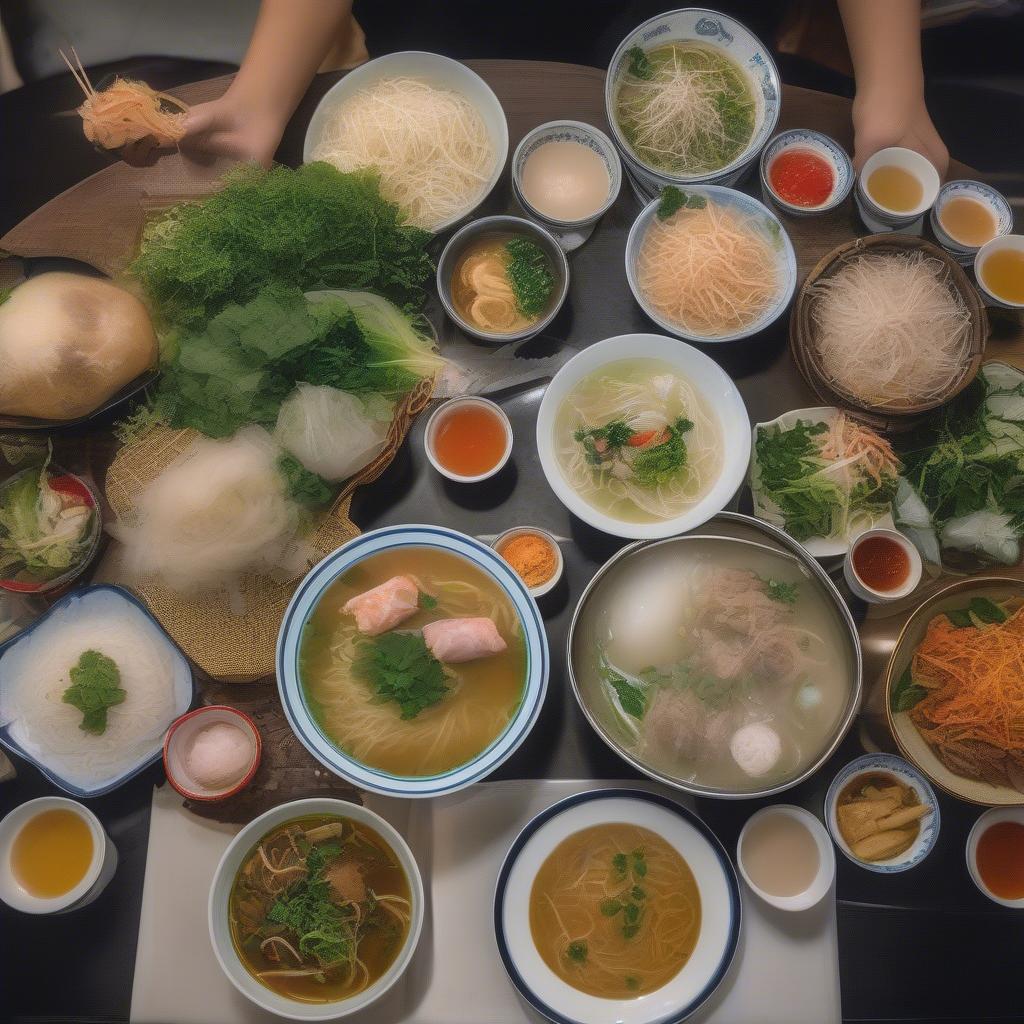Vietnamese street food is more than just a quick and affordable meal; it’s a vibrant tapestry woven into the cultural fabric of the country. From bustling city streets to quaint countryside villages, the aroma of sizzling meats, fragrant herbs, and freshly brewed coffee fills the air, beckoning locals and tourists alike to indulge in a sensory feast. This guide delves into the captivating world of Vietnamese street food, exploring its diverse culinary offerings, regional variations, and the cultural significance that makes it a truly unique experience.
Table Content:
- Decoding the Culinary Landscape: Popular Vietnamese Street Food Dishes
- Regional Flavors: A Culinary Journey Through Vietnam
- Beyond the Bite: The Cultural Significance of Vietnamese Street Food
- Navigating the Street Food Scene: Tips for an Authentic Experience
- Conclusion: Embracing the Flavors of Vietnam
- FAQ
Decoding the Culinary Landscape: Popular Vietnamese Street Food Dishes
Vietnamese street food offers an astounding array of dishes, each boasting unique flavors and textures. One of the most iconic dishes is phở, a flavorful beef noodle soup that has gained international acclaim. Street food vendors often specialize in specific regional variations of phở, showcasing the country’s culinary diversity. Bánh mì, a crusty baguette filled with savory ingredients like pickled vegetables, cilantro, and various meats, is another staple. Its fusion of French and Vietnamese influences reflects the country’s rich history.
 Vietnamese street food vendor prepares banh mi
Vietnamese street food vendor prepares banh mi
Beyond these classics, countless other delicacies await adventurous eaters. Gỏi cuốn, fresh spring rolls filled with vermicelli noodles, shrimp, and herbs, offer a refreshing and healthy option. Bún chả, grilled pork served with vermicelli noodles and a dipping sauce, is a Hanoi specialty that gained international recognition after being featured on a popular travel show.
Regional Flavors: A Culinary Journey Through Vietnam
Vietnamese cuisine is characterized by regional variations, reflecting the diverse geographical and cultural influences across the country. Northern Vietnam is known for its subtle flavors and emphasis on fresh herbs, while central Vietnam boasts bolder, spicier dishes. Southern Vietnam is influenced by its proximity to the Mekong Delta, incorporating more coconut milk and seafood into its cuisine. These regional nuances extend to street food, offering a unique culinary experience in each part of the country.
 A variety of regional Vietnamese street food dishes.
A variety of regional Vietnamese street food dishes.
Beyond the Bite: The Cultural Significance of Vietnamese Street Food
Vietnamese street food is deeply ingrained in the country’s social fabric. It’s a place where people gather to connect, share stories, and enjoy delicious food together. Street food stalls are often family-run businesses, passed down through generations, preserving traditional recipes and cooking techniques. The bustling atmosphere, the vibrant colors, and the enticing aromas create a truly immersive cultural experience. This framework of shared meals strengthens community bonds and fosters a sense of belonging. It represents Who Delivers Your Offer To The Seller Framework in a cultural context, a communal offering of sustenance and connection.
Navigating the Street Food Scene: Tips for an Authentic Experience
For those new to Vietnamese street food, navigating the bustling scene can seem daunting. However, with a few simple tips, you can unlock a world of culinary delights. Don’t be afraid to try new things – street food vendors are often happy to explain their offerings. Look for stalls with long lines of locals, as this is usually a good indicator of quality and popularity. Bargaining is common in some areas, but always be respectful and fair. Most importantly, embrace the experience and enjoy the vibrant atmosphere.
Conclusion: Embracing the Flavors of Vietnam
Vietnamese street food offers a captivating culinary adventure, a journey through a rich tapestry of flavors, aromas, and cultural traditions. From iconic dishes like phở and bánh mì to regional specialties and hidden gems, there’s something to tantalize every taste bud. By embracing the vibrant street food scene, you’ll not only savor delicious food but also gain a deeper understanding of Vietnamese culture and its people. So, step into the culinary whirlwind and discover the magic of Vietnamese street food – a truly unforgettable experience.
FAQ
What are some common vegetarian/vegan street food options in Vietnam? Many vendors offer vegetarian versions of popular dishes, using tofu or mushrooms instead of meat. Look for dishes with “chay” in the name, which indicates they are vegetarian.
Is it safe to eat street food in Vietnam? Generally, street food in Vietnam is safe to eat. Look for stalls that are clean and busy, and avoid raw or undercooked foods.
How much does street food cost in Vietnam? Street food is incredibly affordable, with most dishes costing a few dollars or less.
What are some must-try street food dishes in Hanoi? Bún chả, phở cuốn, and xòe (crispy rice crackers) are some must-try dishes in Hanoi.
Where can I find the best street food in Ho Chi Minh City? Ben Thanh Market and District 4 are popular areas for street food in Ho Chi Minh City.
What is the best way to order street food in Vietnam? Simply point to what you want or use simple phrases like “một” (one) or “hai” (two) to indicate quantity.
Are there any cultural etiquette tips to keep in mind when eating street food in Vietnam? It’s polite to use chopsticks and to finish all the food on your plate. Slurping your noodles is considered a sign of enjoyment.
